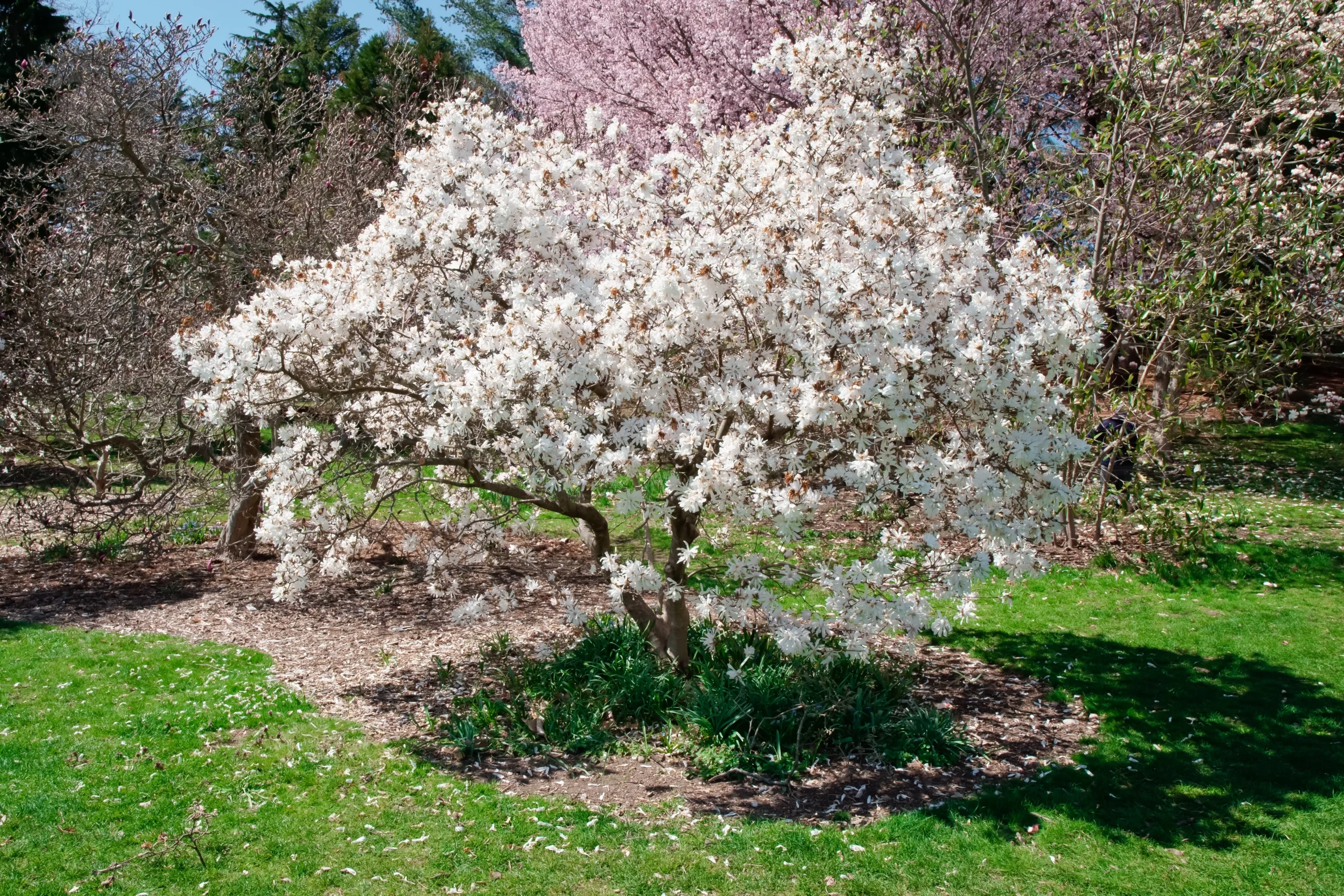Family: Magnolia
Type: Shrub

Star Magnolia, a small, deciduous tree, is renowned for its early spring blooms. Its star-shaped, white flowers emerge before the leaves, signaling the end of winter.
This tree is compact, making it suitable for smaller gardens or spaces. It grows slowly to a height of 15-20 feet, with a similar spread.
Star Magnolia is low-maintenance, requiring minimal care once established. Its fragrant flowers and neat form make it a garden favorite.
Hardiness Zone: 4a-5a
Deer Resistant: Yes
Pet Friendly: Yes
Moisture Preference: Moist
Sun Needs: Full sun to partial shade
Growth Rate: Slow
Average Height (feet): 15
Average Spread (feet): 10
Average Life Span (years): 80
Form: Oval
Flower Color: White
Flower Shape: Star
Bloom Season: In early spring
Foliage Color: Green
Leaf Fall Color: Orange
Foliage Shape: Pointy
Bark Color: Gray
Bark Texture: Smooth
Star Magnolia is a stunning focal point in any yard. Its early blossoms bring life and color after the cold months.
Plant near patios or windows to enjoy its fragrance and beauty up close. Its size makes it perfect for residential landscapes.
Combine with early spring bulbs for a layered color display. This tree’s blooms and emerging greenery herald the spring season effectively.

In formal gardens, Star Magnolia adds elegance and structure. Its symmetrical shape and refined blossoms complement manicured landscapes.
This tree fits well in cottage gardens, offering early spring interest. Its informal shape and lush blooms pair well with a variety of perennials.
Star Magnolia is ideal for Asian-inspired gardens. Its graceful form and stunning blooms create a serene and harmonious atmosphere.
Use as a specimen tree in lawns or borders. Its striking appearance draws the eye and creates a natural centerpiece.
Incorporate into mixed shrub borders for seasonal interest. Its early flowers contrast well with evergreens or late-blooming shrubs.
Plant in groups for a breathtaking spring display. Clusters of Star Magnolia create a dramatic effect with their abundant blooms.
Select our pre-made garden layouts to create a landscape that’s uniquely yours. Simple, smart, and customizable!
In spring, Star Magnolia is a sight to behold with its abundant, fragrant white flowers. The blossoms appear before the leaves, making a striking display.
During summer, its lush green foliage provides a cool, calming presence. The tree maintains a neat, compact shape throughout the season.
In fall, its leaves turn yellow and bronze, adding autumnal charm. The tree's form remains attractive even as the foliage drops.
In winter, the bare branches of Star Magnolia reveal a pleasing, architectural structure. The tree's silhouette provides interest in the dormant garden.
Star Magnolia thrives in a sheltered spot that protects it from harsh winds. An ideal location would be a sunny to partly shaded area in the garden.
It prefers full sun to partial shade. Adequate sunlight is crucial for abundant flowering, but too much direct sun can be detrimental in hotter climates.
This tree flourishes in well-draining, slightly acidic to neutral soil. Amending the soil with organic matter can enhance growth and flowering.
When planting, allow a space of at least 10-15 feet from other plants or structures. This gives the tree room to spread and mature fully.
The best time to plant Star Magnolia is in the early spring or fall. Cooler temperatures help the roots establish without the stress of extreme heat or cold.
Plant at the same depth it was in its container. Ensure the root ball is well-watered before planting and settle the soil gently around it.
Regular watering is essential, especially in the first few years. The soil should be kept moist but not waterlogged.
Apply a balanced, slow-release fertilizer in early spring. This supports healthy growth and flowering.
Minimal pruning is needed. If required, prune after flowering to maintain shape and remove any dead or diseased wood.
In spring, mulch and water well to support the growth of new flowers and leaves. Protect from late frosts if necessary.
Continue regular watering, especially in dry periods. Monitor for pests and diseases, treating as needed.
Prepare the tree for winter by reducing watering and removing any fallen leaves around the base to prevent rot.
No special care is needed in winter. However, in colder regions, a layer of mulch can help protect the roots from freezing temperatures.
Yes, Star Magnolia can be grown in large pots, but they prefer being planted in the ground. Regular watering and fertilizing are crucial for potted trees.
Star Magnolia is a slow-growing tree, typically growing a few inches to a foot per year. Patience is key to seeing it reach its full splendor.
While generally robust, they can be prone to leaf spot and canker, especially in wet conditions. Good air circulation and proper care can minimize these issues.
Sign up below to get exclusive deals, discounts, and new plant collections—delivered straight to your inbox! Plus, stay inspired with the latest gardening tips, landscaping trends, and DIY garden ideas. Start growing with us today!
A big thank you for subscribing to the PBN Design newsletter.
We're thrilled to have you join our community. Get ready for exciting updates, insightful content, and more delivered straight to your inbox.
Stay tuned!
Go backA big thank you for subscribing to the PBN Design newsletter.
We're thrilled to have you join our community. Get ready for exciting updates, insightful content, and more delivered straight to your inbox.
Stay tuned!
Go back